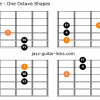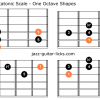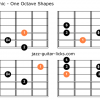Pentatonic Scales
Pentatonic scales are frequently used in music all over the world : Eastern, European, Mediterranean, African, Amerindian, Oceania.
The word "pentatonic" comes from the Greek word "pente" meaning five and "tonic" meaning tone.
They are considered earlier than heptatonic scales and can be divided in two categories :
-
Containing semitones (hemitonic)
-
Without semitones (anhemitonic)
There are many pentatonic scales, the best known are the major pentatonic scale and the minor pentatonic scale (also known as "the relative minor pentatonic"). They do not have semitones (anhemitonic).
These two scales are very important for jazz blues guitar players and improvisers.
The Five Modes Of The Major Pentatonic Scale
Each degree of the major pentatonic scale (which is what we are interested in) can provide a tonic for a mode. There are five modes :
Mode I (major pentatonic) which consists of the first, second, major third, perfect fifth and sixth.
Mode II aka Egyptian pentatonic scale or suspended pentatonic (no third, suspended scale) : 1 - 2 - 4 - 5 - b7
Mode III (Blues minor) aka Man Gong scale (minor) : 1 - b3 - 4 - b6 - b7
Mode IV (Blues Major) aka Ritusen scale (no third, suspended scale) : 1 - 2 - 4 - 5 - 6
Mode V (minor pentatonic) that contains the same five notes as the major pentatonic scale, but its tonic (first note of the scale) is three semitones below the tonic of the major pentatonic scale : 1 - b3 - 4 - 5 - b7
The Relative Minor
What's the relative minor pentatonic scale ?
For every major scale there is a relative minor scale and for every minor scale there is a relative major.
- Relative minor scales begin on the sixth degrees of major scales.
- Relative major scales begin on the third degree of minor scales.
These two rules work for all the scales and chords.
Let's take an example with the C major pentatonic (C - D - E - G - A). It has the same notes as the A minor pentatonic (A - C - D - E - G). The sixth degree of the major pentatonic scale is the tonic of the minor pentatonic scale.

Now another example with the G minor pentatonic scale (G-Bb-C-D-F). The relative major pentatonic scale start on the third degree of G minor. Thus giving the Bb pentatonic scale (Bb-C-D-F-G).

Rare Pentatonic Scales
Now that we have talked about the most played pentatonic scales, here are some other pentatonic scales rarely used, some of them have altered notes :
The following are from the major scale :
Dorian pentatonic scale : 1 - 2 - b3 - 5 - 6. This scale is sometimes referred to as "Kumoï".
Phrygian pentatonic scale aka Dorian b2 pentatonic : 1 - b2 - 4 - 5 - b7
Lydian pentatonic scale : 1 - 2 - 3 - #4 - 6 (major pentatonic scale with a sharp eleventh instead of the perfect fifth). There are two other versions : 1 - 3 - #4 - 6 - 7 and 1 - 3 - #4 - 5 - 6.
Mixolydian pentatonic scale or dominant pentatonic scale : 1 - 2 - 3 - 5 - b7 (mixolydian mode without the sixth and the fourth).
Mixolydian pentatonic scale (second version) 1 - 3 - 4 - 5 - b7.
Aeolian pentatonic scale : 1 - 2 - b3 - 5 - b6. It is also named "Hirajoshi scale".
Locrian pentatonic scale - 1 - b3 - 4 - b5 - b7 (Locrian mode without flat ninth and flat sixth).
It's possible to build pentatonic scales from the melodic minor scale :
Melodic minor pentatonic scale aka minor major 7 pentatonic scale : 1 - b3 - 4 - 5 - 7 (this is the melodic minor mode without the second and the sixth)
Major seventh sharp fifth pentatonic scale : 1 - 2 - 3 - #5 - 6
Seventh sharp eleventh pentatonic scale (Lydian pentatonic scale) : 1 - 2 - 3 - #4 - 7 (this pentatonic is related to the lydian dominant mode, fourth mode of the melodic minor scale)
Seventh flat thirteenth pentatonic scale : 1 -2 -3 -b6 -b7 (related to the mixolydian b13 mode)
Minor ninth flat fifth : 1 - 2 - b3 - b5 - b7 (related to the sixth mode of the harmonic minor scale)
Altered Pentatonic Scales
Dominant #11 pentatonic scale : (1-2-3-#4-b7)
Altered pentatonic scale aka 7b9 pentatonic scale : (1-b2-3-5-b7)
Exotic Pentatonic Scales
Here are some exotic scales made of five notes.
Egyptian scale aka suspended pentatonic (1 - 2 - 4 - 5 - b7). This is the second mode of the major pentatonic scale.
Man gong scale : 1 - b3 - 4 - b6 - b7. It is a Chinese scale.
Pelog pentatonic scale : 1 - b2 - b3 - 5 - b6 . It is an Indian scale derived from the Pelog scale.
Ritusen scale : 1 - 2 - 4 - 5 - 6.
Pygmy scale : 1 - 2 - b3 - 5 - b7. It is an african scale, discussed quickly here.
Scottish Pentatonic Scale : 1 - 2 - 4 - 5 - 6.
Balinese Pelog Scale : 1 - b2 - b3 - 5 - b6.
Mongolian Scale : 1 - 2 - 3 - 5 - 6.
Japanese Scales
Kumoïjoshi (mode I): 1 - b2 - 4 - 5 - b6 or 1 - 2 - b3 - 5 - 6.
Chinese scale (mode II) : 1 -3 - #4 -5 - 7.
Hirajoshi scale (mode III) : 1 - 2 - b3 - 5 - b6.
Iwato scale (mode IV): 1 - b2 - 4 - b5 - b7.
Japanese (mode V) - 1 - 3 - 4 - 6 - 7.
Asian Pentatonic Scales
In Sen Scale (Mode I) : 1 - b2 - 4 - 5 - b7.
Asian scale (Mode II) : 1 - 3 - b5 - 6 - 7
Asian scale (Mode III) : 1 - 2 - 4 - 5 - b6
Kokinjoshi scale (Mode IV) : 1 - b3 - 4 - b5 - b7
Kumoï scale (Mode I) : 1 - b2 - 4 - b5 - b7
Kumoï scale (Mode II) : 1 - 3 - 4 - 6 - 7
Kumoï scale (Hon-Kumoï-joshi) (Mode III) : 1 - b2 - 4 - 5 - b6
Kumoï scale (Mode IV) : 1 - 3 - #4 - 5 - 7
Kumoï scale (Mode V) : 1 - 2 - b3 - 5 - 6
Han Kumoï : 1 - 2 - 4 - 5 - b6
Other Pentatonic Scales
Dominant pentatonic scale : 1 - 2 - 3 - 5 - b7
Dorian b2 pentatonic scale : 1 - b2 - 4 - 5 - b7
Diminished pentatonic Scale : 1 - b2 - b3 - b5 - bb7
Lydian dominant pentatonic scale : 1 - 3 - #4 - 5 - b7 or 1 - 2 - 3 - #4 - b7
-
The Major Pentatonic Scale | Guitar Lesson & Diagrams
This guitar lesson provides some fretboard diagrams, charts for a better understanding of the major pentatonic scale -
The Minor Pentatonic Scale | Guitar Lesson with Diagrams
This lesson with tabs, theory, diagrams and lines shows you how to master the minor pentatonic scale on guitar. -
Suspended Pentatonic Scale (Egyptian) - Guitar Charts
This guitar lesson provides chart and shapes for practicing the Egyptian scale aka suspended pentatonic scale. -
Man Gong Scale aka Blues Minor Scale For Guitar - Charts and Shapes
This guitar lesson provides charts and shapes for a better understanding of the man gong scale. -
The Ritusen Scale aka Blues Major or Scottish Pentatonic | Theory Lesson with Guitar Shapes
You will find in this lesson some guitar diagrams and charts to understand the ritusen scale aka raga durga. -
The Dominant Pentatonic Scale - Guitar Lesson with Diagrams and Charts
This guitar lesson provides some diagrams, licks and formula charts about the dominant pentatonic scale, aka mixolydian pentatonic. -
The Mixolydian Pentatonic Scale - Guitar Diagrams And Formula Charts
A brief lesson to learn how to build and play the Mixolydian pentatonic scale on guitar. -
7b9 Pentatonic Scale - Altered Pentatonic Scale - Guitar Lesson with Diagrams
This guitar lesson with tabs, charts and neck diagrams explains what is the dominant seventh flat ninth pentatonic scale. -
The Dorian Pentatonic Scale aka Kumoï and John Coltrane Pentatonic For Guitar
This guitar lesson whit charts and shapes explains what is the Dorian pentatonic scale also known as Kumoï scale and John Coltrane pentatonic scale. -
The Dorian b2 pentatonic Scale aka Phrygian Pentatonic - Guitar Shapes, Licks and Theory
This lesson with guitar shapes explains what is the Dorian b2 pentatonic scale also known as Phrygian pentatonic or Dorian b9 pentatonic. -
The Diminished Pentatonic Scale - Guitar Diagrams & Theory
This guitar lesson explains what is the diminished pentatonic scale and how to play it on guitar. -
The Half-Diminished Pentatonic Scale - Theory, Licks and Guitar Shapes
This guitar lesson with charts and licks explains what are the half-diminished pentatonic scales and how to play them on guitar. -
Minor 6 Pentatonic Scale - Guitar Lesson With Shapes And Licks
This guitar lesson is about the minor sixth pentatonic scale. How to play it on guitar, how to improvise with. -
The Lydian Pentatonic Scale - Guitar Shapes and Theory
This guitar lesson with shapes and tabs offers a quick explanation of the Lydian pentatonic scale. -
The Lydian Dominant Pentatonic Scale For Guitar - Charts, Theory and Shapes
This lesson with shapes and charts explains what is the Lydian dominant pentatonic scale and how to play it on the guitar. -
The Aeolian Pentatonic Scale aka Hirajoshi Scale - Shapes, Charts and Theory For Guitar
This lesson with charts and shapes explains what's the Aeolian pentatonic scale aka Hirajoshi scale and how to play it on guitar. -
The Locrian Pentatonic Scale - Guitar Shapes and Formula Charts
This lesson provides shapes and charts to play the Locrian pentatonic scale on guitar.

















